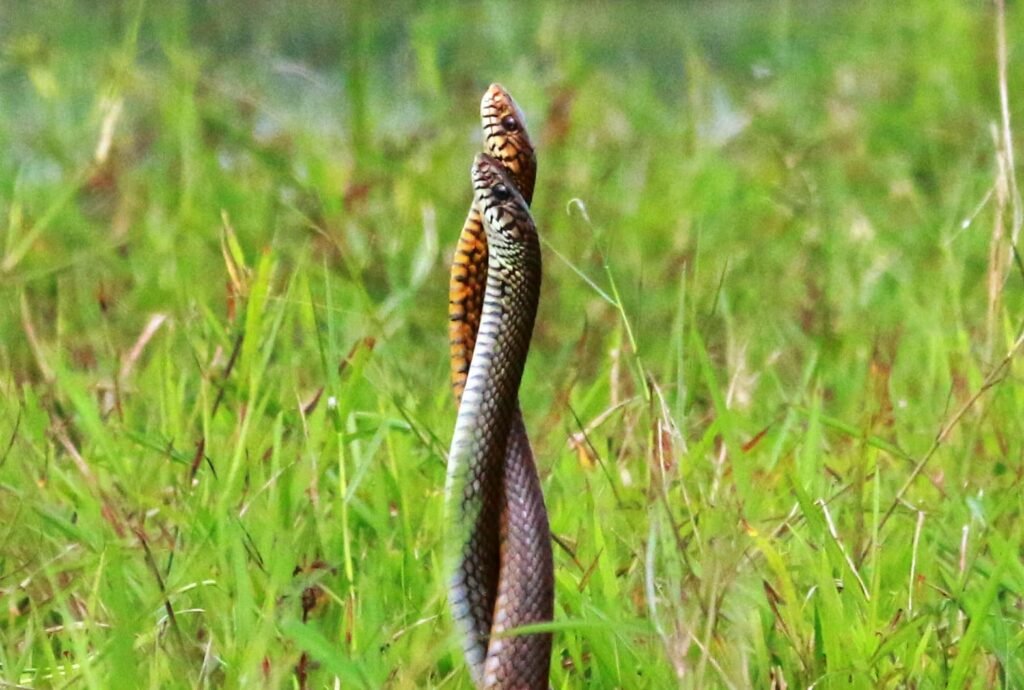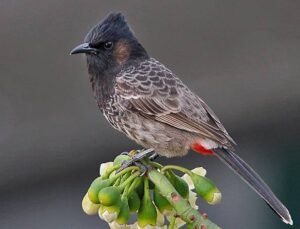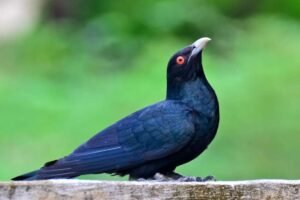Introduction to Indian Rat Snake
The Indian Rat Snake (Ptyas mucosa) is one of the most commonly sighted snakes across the Indian subcontinent. Despite its large size and rapid movements, it is completely non-venomous and harmless to humans. The Indian Rat Snake plays a vital role in controlling rodent and pest populations, especially in agricultural areas and human settlements. Due to its adaptability and prevalence, this species is often mistaken for venomous snakes like cobras, leading to unnecessary fear and killings. Found in varied habitats ranging from forests to urban locales, this reptile has coexisted with humans for centuries. On the website wildlifenest.com, our goal is to spread awareness about such misunderstood reptiles and their importance in biodiversity.
Indian Rat Snake
Species Profiles (Indian Rat Snake)
| Feature | Description |
|---|---|
| Snake Name | Indian Rat Snake |
| Scientific Name | Ptyas mucosa |
| Wildlife Protection Act (WLPA) Schedule | Schedule II |
| Regional Names | Hindi: धामन (Dhaman) Bengali: ধারাজ / দারাজ (Dharaj / Darash – both are used) Marathi: धामण (Dhaman) Gujarati: ધામણ (Dhaman) Tamil: சாரை பாம்பு (Saarai Paambu) Telugu: జెర్రి పోతు (Jerri Pothu) / జెర్రి గొడ్డు (Jerri Goddu) Malayalam: ചേര (Chera) / ഇടിഞ്ഞിൽ (Idinjil) Kannada: ಕೇರೆ ಹಾವು (Kere Haavu) Oriya (Odia): ଧାମନା ସାପ (Dhamana Saap) Assamese: বাইৰুণী সাপ (Bairooni Saap) |
| Physical Description | Long and slender body; average length 5 to 8 feet; color varies from olive brown to yellowish with black crossbars; round pupils; glossy scales. |
| Habitat | Fields, farmlands, forests, urban gardens, water canals, wetlands. |
| Diet | Rodents, lizards, frogs, birds, and their eggs. |
| Behaviour | Diurnal (active during the day); fast-moving; excellent climber and swimmer; often seen basking. |
| Venomous/Non-Venomous | Non-Venomous |
| Venom Type | None (Does not produce venom) |
| Venom Effects on Prey | Kills prey by constriction or swallowing alive due to lack of venom. |
| Venom Effects on Humans | Harmless; bite may cause minor swelling or scratch but no toxic effects. |
| Common or Rare Species | Very Common |
| Life Span | 10 to 15 years in the wild; can live longer in captivity. |
| Mating & Reproduction | Breeds once a year; lays 6–15 eggs in burrows or under logs; hatchlings are independent from birth. |
Introduction to Snakes – Indian Rat Snake Focus
Snakes, including the Indian Rat Snake, are limbless reptiles known for their elongated bodies, flexible jaws, and forked tongues. The Indian Rat Snake showcases many typical features of colubrid snakes – large eyes with round pupils, smooth glossy scales, and high agility. As a non-venomous snake, it depends on its speed and strength to catch prey and avoid predators. Unlike venomous species that inject toxins to immobilize prey, the Indian Rat Snake often constricts or directly swallows its catch.
In the ecosystem, these snakes serve as essential pest controllers. Their primary diet includes rats and other vermin that are considered agricultural threats. By reducing these pests naturally, they help maintain the balance between crops and pests, reducing the need for chemical pesticides.
Many myths surround snakes in general. Some believe that all snakes are poisonous, that they drink milk, or that they chase humans—all of which are false. The Indian Rat Snake is often killed due to these misconceptions. At wildlifenest.com, we aim to break these myths and offer scientific, easy-to-understand education about these creatures.

Habitat and Distribution of Indian Rat Snake
Indian Rat Snakes are highly adaptable and are found in a wide variety of habitats. They thrive in moist environments like wetlands and paddy fields, but they are equally comfortable in dry scrublands and urban settlements. You may find them near human dwellings, especially where rodent activity is high. Their ability to swim and climb trees allows them to explore both terrestrial and arboreal regions efficiently.
Their distribution is widespread across the Indian subcontinent, including countries like India, Bangladesh, Nepal, Sri Lanka, and Pakistan. This species is commonly found in states like Maharashtra, Kerala, Tamil Nadu, West Bengal, and even in urbanized states like Delhi and Karnataka. In rural areas, farmers often consider them beneficial for controlling pests.
| Habitat Type | Examples |
| Forests | Tropical and deciduous forests across central and southern India |
| Urban Areas | City gardens, sewage drains, abandoned buildings |
| Wetlands | Canals, riverbanks, marshlands, paddy fields |
| Drylands | Scrublands and rocky terrains |
| Agricultural Fields | Sugarcane, rice, and wheat fields with high rodent activity |
| Country | Distribution |
| India | Almost all regions |
| Nepal | Southern lowlands |
| Sri Lanka | Widespread across habitats |
| Bangladesh | Common in rural and urban areas |
| Pakistan | Mostly in the eastern regions |
Snake Behaviour – Indian Rat Snake
Indian Rat Snakes are diurnal hunters, meaning they are most active during the day. They are agile, fast-moving, and often seen with their heads raised, scanning the environment for prey. They primarily hunt rodents, birds, eggs, and frogs, making them beneficial in human-populated areas. The Indian Rat Snake swallows its prey whole, often alive, due to its non-venomous nature.
Reproduction takes place once a year, usually before the monsoon. During courtship, males may engage in combat to impress females. Females lay eggs in burrows or hidden spots under logs or debris. Hatchlings emerge in 60 to 80 days, already capable of hunting.
As a defense mechanism, Indian Rat Snakes may emit a loud hiss and inflate their body to appear larger. Some even mimic the hood-spread behavior of a cobra to scare off predators. They might bite if cornered but do not pose any venomous threat.
First Aid and Medical Treatment for Indian Rat Snake Bites
Although Indian Rat Snakes are non-venomous, bites can still occur if the snake feels threatened. These bites are not toxic but may cause minor pain, swelling, or skin punctures due to their sharp teeth. Immediate treatment includes washing the area thoroughly with soap and water, applying antiseptic, and monitoring for infection. Tetanus shots may be recommended.
Medical treatment is rarely necessary unless there is a bacterial infection or allergic reaction. It is important not to panic or assume the bite is venomous. A calm assessment and basic first aid are usually sufficient.
Global Impact of Indian Rat Snake Bites
Globally, the Indian Rat Snake poses no significant medical threat due to its non-venomous nature. There are very few reported complications from its bite. However, it has a strong ecological impact by controlling rodent populations in regions where it thrives. In agricultural economies like India, this reduces the need for rodenticides and helps protect crops. Misidentification with venomous species does cause unnecessary panic, which is something education can resolve.
If You Encounter a Snake on Your Property
Remain Calm and Assess the Situation: Most snakes, including the Indian Rat Snake, are shy and avoid humans. Stay still and observe from a safe distance.
Ensure Safety: Keep children and pets away. Do not attempt to handle the snake yourself.
Identify the Snake (If Possible): Use distinguishing features like head shape, color, and behavior to identify if it’s venomous or not.
Contact Professional Help: Call local wildlife rescue or forest officials who are trained in snake rescue and relocation.
Prevent Future Encounters: Seal holes in walls, clean garbage, and trim garden bushes to avoid creating snake-friendly zones.
Educate Yourself and Others: Learn about local snake species and teach your family about which ones are dangerous and which are not.
Tips for Snake Enthusiasts
How to Safely Observe Snakes in the Wild: Maintain a respectful distance, wear protective footwear, and avoid disturbing their natural habitat. Early mornings and late evenings are ideal for observation.
Tips for Aspiring Herpetologists: Start with basic field guides, volunteer in wildlife rescue centers, and participate in reptile surveys. Always follow ethical observation and safety practices.
Interesting Facts about Indian Rat Snake
- Incredible Speed: Indian Rat Snakes are among the fastest-moving snakes in India, often reaching speeds that surprise onlookers. This speed helps them chase prey and escape threats efficiently.
- Cobra Mimicry: When threatened, the Indian Rat Snake can raise the front portion of its body and flatten its neck in a manner similar to a cobra, fooling both predators and humans.
- Excellent Swimmers and Climbers: These snakes are equally adept in water and on trees, often climbing tall branches to steal eggs from bird nests or swim across rivers to hunt.
- Play Dead Trick: In extreme threats, some individuals have been seen playing dead—becoming completely motionless to avoid attention.
- Voice of a Hiss: Their hiss is loud and powerful, often mistaken for that of a cobra, and serves as a primary defense mechanism.
- Harmless yet Hated: Despite being completely non-venomous, they are often killed due to fear and confusion with venomous species.
- Rodent Specialist: In agricultural regions, they are affectionately referred to as the “farmer’s friend” due to their expertise in hunting rats and mice.
- Ecosystem Cleaner: Besides rodents, they also feed on roadkill and carcasses, helping clean the environment.
- Color Variations: Their skin color varies depending on the habitat – darker in forests and lighter in open lands.
- Survivors in Urban Jungles: Adaptability has made them a successful species even in bustling cities like Mumbai, Delhi, and Kolkata.
FAQs About Indian Rat Snake (Ptyas mucosa)
1. Is the Indian Rat Snake venomous?
No, the Indian Rat Snake is non-venomous. It may look intimidating due to its size and defensive posture, but it poses no venomous threat to humans.
2. What is the scientific name of the Indian Rat Snake?
The scientific name of the Indian Rat Snake is Ptyas mucosa. It belongs to the Colubridae family, which includes many non-venomous snake species.
3. Where are Indian Rat Snakes commonly found?
Indian Rat Snakes are widely distributed across India and South Asia. They can be found in forests, grasslands, wetlands, agricultural fields, and even in urban areas like gardens and buildings.
4. What do Indian Rat Snakes eat?
They primarily feed on rodents, which makes them highly beneficial to farmers. They also eat frogs, lizards, birds, and eggs.
5. How can I identify an Indian Rat Snake?
They are long, slender snakes that can grow over 2 meters in length. Their color varies from olive brown to yellowish, with a light underbelly and faint patterns along the body. When threatened, they may raise their head and hiss loudly.
6. Are Indian Rat Snakes protected under the law?
Yes, Indian Rat Snakes are protected under the Wildlife Protection Act (WLPA) of India, 1972 – Schedule II, which means killing or capturing them is illegal.
7. Do Indian Rat Snakes enter homes?
Yes, they may enter homes, especially if there is a rodent problem. However, they are not aggressive and will try to escape when encountered by humans.
8. What should I do if I see one in my home or garden?
Remain calm and do not try to handle it. Contact local wildlife authorities or a snake rescue team to relocate it safely.
9. Can Indian Rat Snakes climb trees?
Yes, they are excellent climbers and often climb trees to hunt for birds or eggs.
10. Are Indian Rat Snakes dangerous to pets?
They are not typically dangerous to pets. However, they might defend themselves if provoked. It is advisable to keep pets away and call a professional if the snake is inside your property.
11. How do Indian Rat Snakes reproduce?
Mating usually occurs in the spring or early summer. Females lay 6–15 eggs, which hatch in about 2 months. The young snakes are independent from birth.
12. How long do Indian Rat Snakes live?
In the wild, they typically live for about 10 to 15 years, depending on environmental conditions and threats.
13. Can Indian Rat Snakes mimic cobras?
Yes, when threatened, they can raise the front part of their body and flatten their neck, resembling a cobra. This mimicry helps deter predators, even though they are not venomous.
14. What is the ecological role of Indian Rat Snakes?
They help control the rodent population, making them ecologically important for natural pest control and agricultural health.
15. Why are Indian Rat Snakes often misunderstood?
Due to their size and resemblance to venomous snakes like cobras, they are frequently killed out of fear, despite being harmless. Education and awareness are key to promoting their conservation.
Related Snake Species – Explore More on Wildlife Nest
| Snake Article | Link |
|---|---|
| Indian Rock Python | Read Article |
| Two-Step Snake (Wolf Snake) | Read Article |
| Slender Coral Snake | Read Article |
| Green Vine Snake | Read Article |
| Common Cat Snake | Read Article |
| Banded Krait Snake | Read Article |
| King Cobra | Read Article |
किंग कोबरा: दुनिया का सबसे लंबा ज़हरीला सांप! | King Cobra: World’s Longest Venomous Snake!


